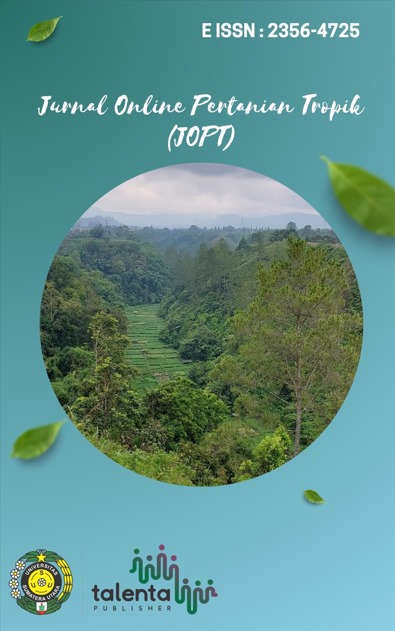The Relationship between Climate and Productivity of Tea Plants (Camellia sinensis L.) in Bah-Butong Gardens PT. Perkebunan Nusantara IV, North Sumatra Province in 2005-2009.
DOI:
https://doi.org/10.32734/jopt.v11i2.17559Keywords:
Tea, Tea Productivity, ClimateAbstract
Fluctuations in tea plant productivity are influenced by several climate factors, such as rainfall, number of rainy days, sunlight intensity, temperature and humidity. This research aims to evaluate the impact of climate factors on the productivity of Tea plants in the Bah-butong Plantation of PT. Perkebunan Nusantara IV, Simalungun Regency, North Sumatra. The hypothesis of this research is that rainfall, number of rainy days, sunlight intensity, temperature and humidity partially or simultaneously have a significant influence on the productivity of tea plants at the location. The research was conducted from September 2023 – Desember 2023, with data collection through field surveys and secondary data collection from related agencies. The data collected includes rainfall, number of rainy days, sunlight intensity, temperature, humidity and tea. The analysis method used is multiple linear regression and correlation analysis using statistical software SPSS.v.22 for Windows. The results of the regression analysis show that rainy days and temperature do not have a partially significant effect on increasing tea production. However, rainfall, amount of sunlight, humidity have a significant effect on increasing tea production. The results of the regression analysis show that rainfall, number of rainy days, sunlight intensity, temperature and humidity do not have a significant influence on increasing tea production.
Downloads
References
Central Bureau of Statistics. 2014. Tea Statistics in Indonesia. [On line]. Available: https:// media.neliti.com/media/publications/487 11-ID-statistik-teh-indonesia-2014.pdf. Accessed September 1, 2016
Please M. Fadil. DA, Irsal and Ginting J. 2021. The Influence of Climate on the Productivity of Tea Plants (Camellia sinensis L.) in the Tobasari Gardens of PT. Perkebunan Nusantara IV, Pematang Sidamanik District, Simalungun Regency, North Sumatra Province. Faculty of Agriculture. University of Northern Sumatra. Thesis. https://repository.usu.ac.id/handle/123456789/47195?show=full
Tea and Cinchona Research Center, 2006. Technical Instructions for Tea Plant Culture. Bandung. 191 p
Setyamidjaja, D. 2000. Tea cultivation and post-harvest processing. Canisius. Yogyakarta
Sudjarmoko, B. 2014. Development of Indonesian tea in the domestic and international markets.[Online]. Available: balittri.litbang.pertanian.go.id. Accessed 24 August 2016.
Setyamidjaja, D. 2010. Tea cultivation and post-harvest processing. Kanisius. Yogyakarta.
Utomo, M. Bayu Dwi, Irsal and Ginting J. 2018. The Influence of Climate on the Productivity of Tea Plants (Camellia sinensis L.) in the Sidamanik Gardens of PT. Perkebunan Nusantara IV. Thesis. http://repository.usu.ac.id/handle/123456789/12651
Downloads
Published
How to Cite
Issue
Section
License
Copyright (c) 2024 Jurnal online PERTANIAN TROPIK

This work is licensed under a Creative Commons Attribution-ShareAlike 4.0 International License.






















